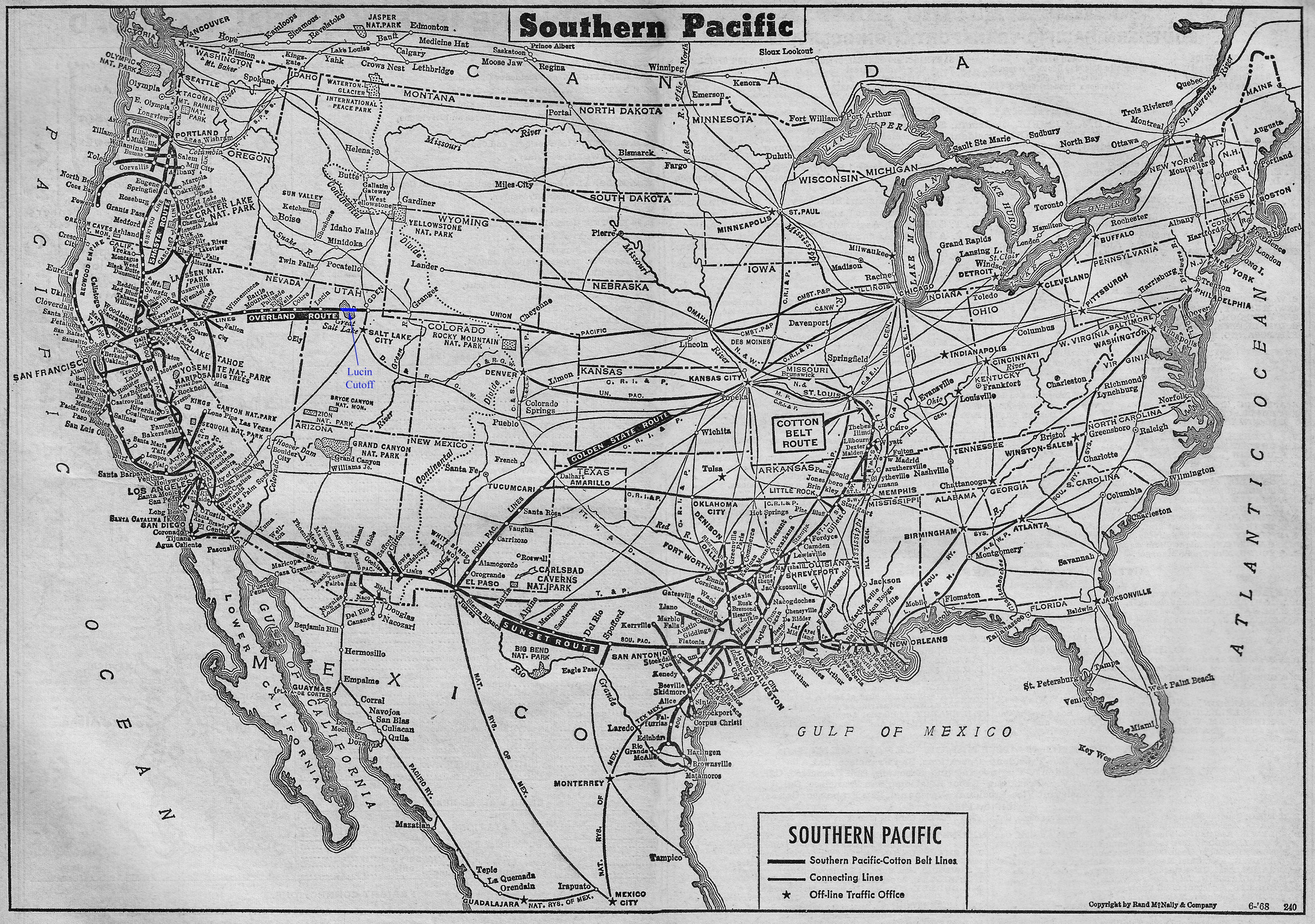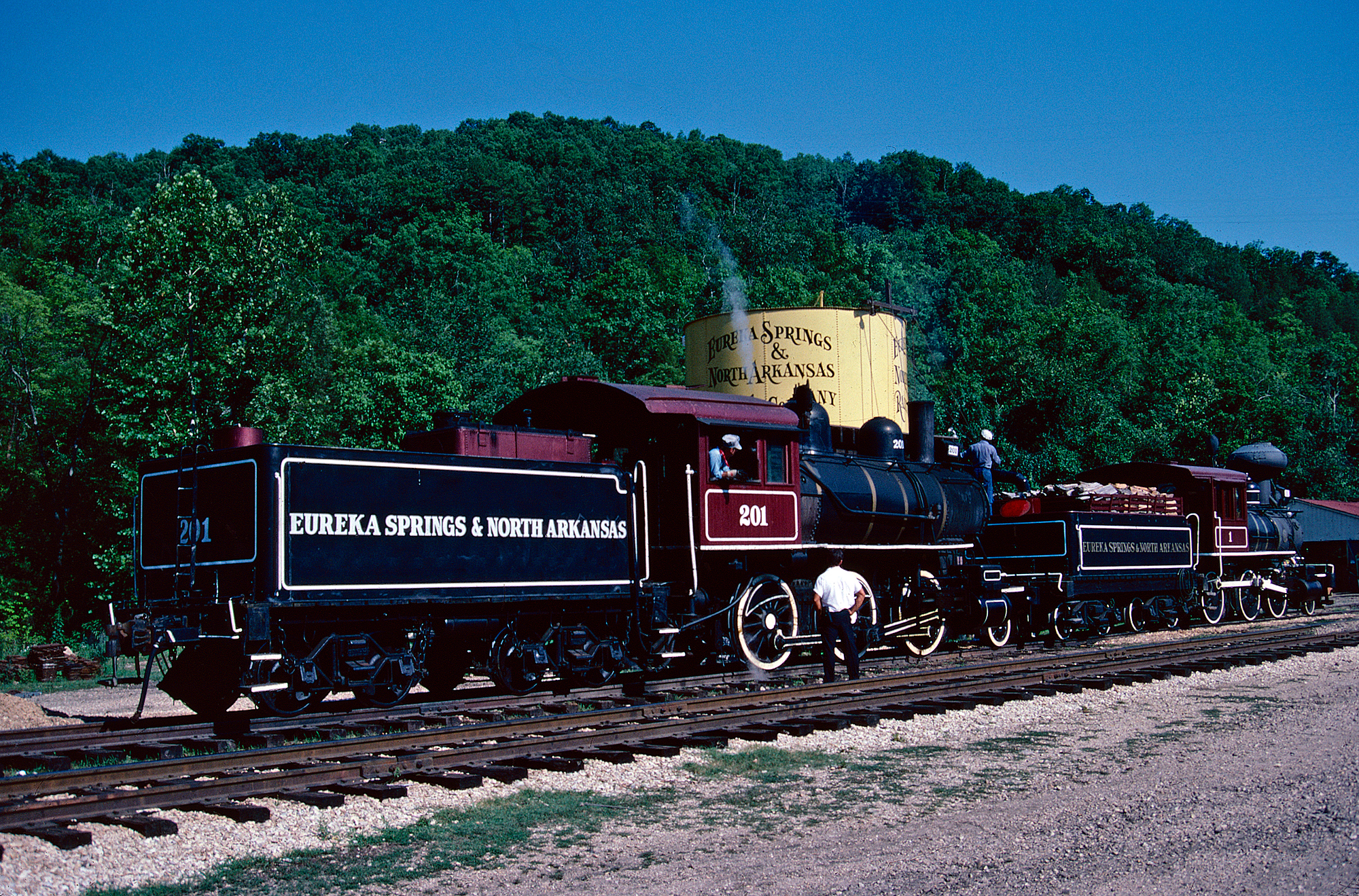Lucin Cutoff and Great Salt Lake Causeway
Last revised: August 24, 2024
By: Adam Burns
The Lucin Cutoff is a 102-mile railroad line in Utah that runs from Ogden to its namesake in Lucin. Built by the Southern Pacific between 1902 and 1904, it forms part of the Overland Route and bypasses the original Central Pacific route around the northern end of the Great Salt Lake.
Almost everyone knows something about the famous meeting at Promontory, Utah in May, 1869 between the Central Pacific and Union Pacific which completed the Transcontinental Railroad.
The CP, of course, became part of the Southern Pacific system and it was not until around 1900 that serious consideration and planning began for what became the Lucin Cutoff.
As noted above the line totals 102 miles although its most notable feature is a 12-mile long trestle crossing the lake, which was replaced by a causeway in the late 1950s. This causeway is still utilized by successor Union Pacific today.
Photos
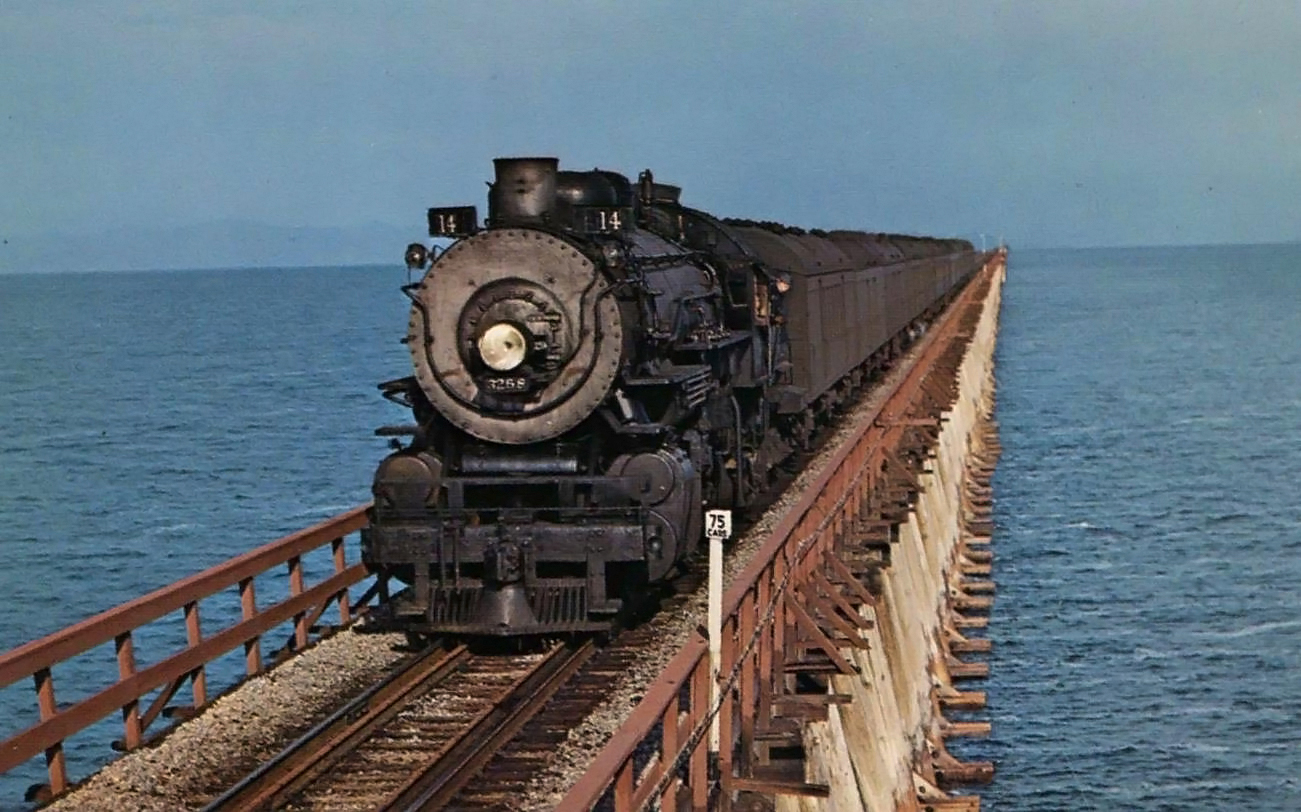 A Southern Pacific company photo with 2-8-2 #3258 (MK-6) ahead of train #14, the westbound "Pacific Limited," crossing the original wooden trestle spanning Utah's Great Salt Lake, circa 1950.
A Southern Pacific company photo with 2-8-2 #3258 (MK-6) ahead of train #14, the westbound "Pacific Limited," crossing the original wooden trestle spanning Utah's Great Salt Lake, circa 1950.History
In an attempt to keep costs low and complete the first Transcontinental Railroad as quickly as possible, a low-grade line across the Great Salt Lake was shelved by Central Pacific engineers during the late 1860s.
The completed line, however, required the CP to build a circuitous and steep route around the lake with grades peaking at 2.2%.
Beginning at Lucin the line headed northeast through the Promontory Mountains with much of the grading work to Promontory Summit carried out by Benson, Farr, & West.
Interestingly, after the ceremonies of May 10, 1869 the CP quickly abandoned its grade that continued on from Promontory to Ogden in favor of the Union Pacific's alignment.
In 1885 the CP became a part of the growing Southern Pacific system and through the end of the 19th century the original alignment from Ogden to Lucin remained the main line. This corridor stretched 146 miles and climbed to an elevation of 700 feet above the lake.
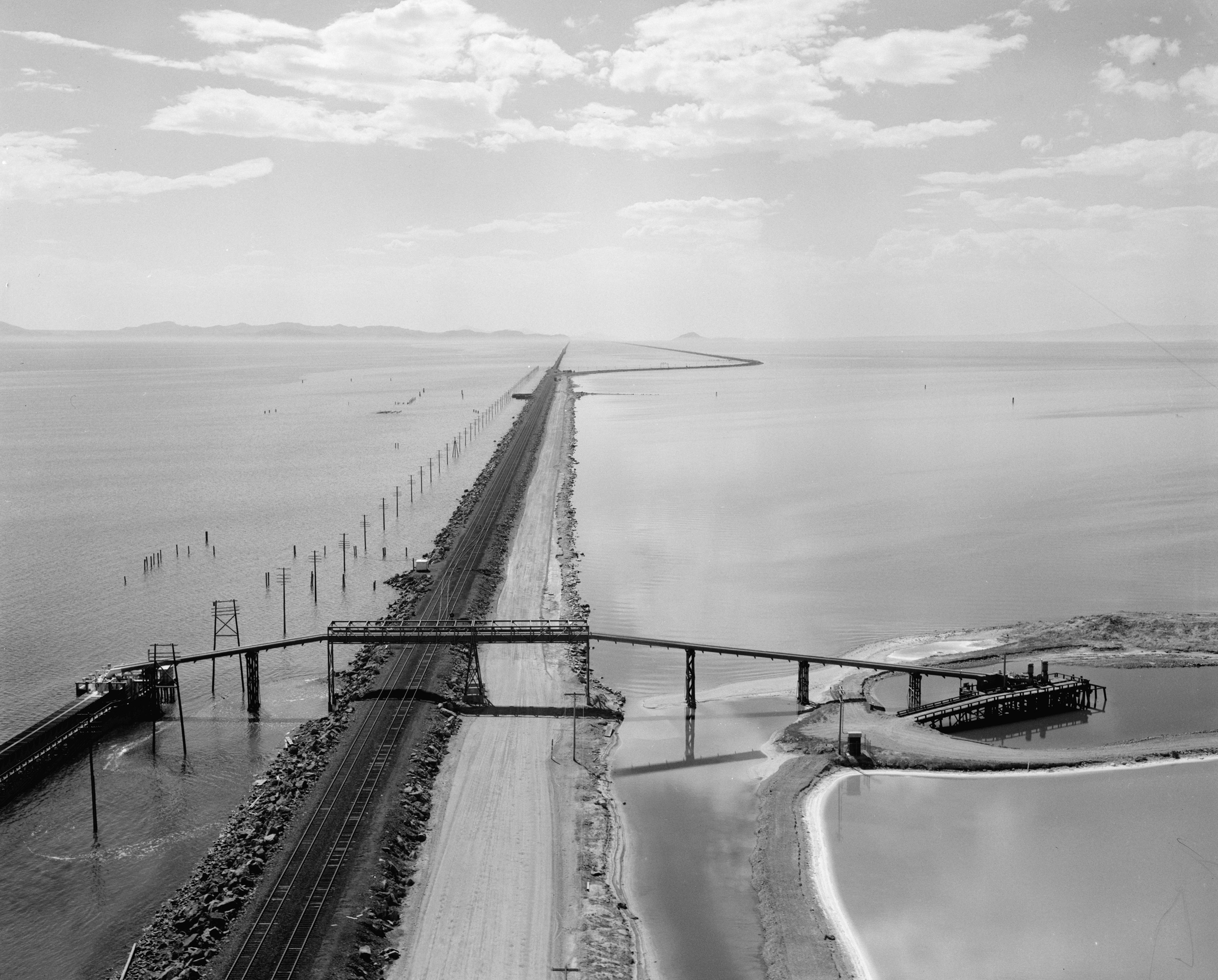 Looking directly west across the Great Salt Lake in August, 1971 we see the Lucin Cutoff. The original grade ran straight ahead while the new alignment, which opened in 1959, splits away to the right. Since this photo was taken the original causeway has been entirely removed. Jack Boucher photo.
Looking directly west across the Great Salt Lake in August, 1971 we see the Lucin Cutoff. The original grade ran straight ahead while the new alignment, which opened in 1959, splits away to the right. Since this photo was taken the original causeway has been entirely removed. Jack Boucher photo.Construction
In 1899 plans finally commenced on a water level route that would directly span the lake to its north with Lucin as the western terminus of the old alignment.
The Ogden & Lucin Railroad was a paper company created for the express purpose of building the new Cutoff with work officially commencing March, 1902.
Interestingly, the wooden trestle spanning the lake consitutes only 12 miles of the Lucin Cutoff. It was originally hoped the route would be a causeway, similar to what was built later.
However, construction techniques at the time, while advanced, were not able to stabilize the right-of-way from sinking into the lake. As a result, engineers decided on a more conventional approach; long earthen approaches built of stone-fill with a wooden trestle in the center.
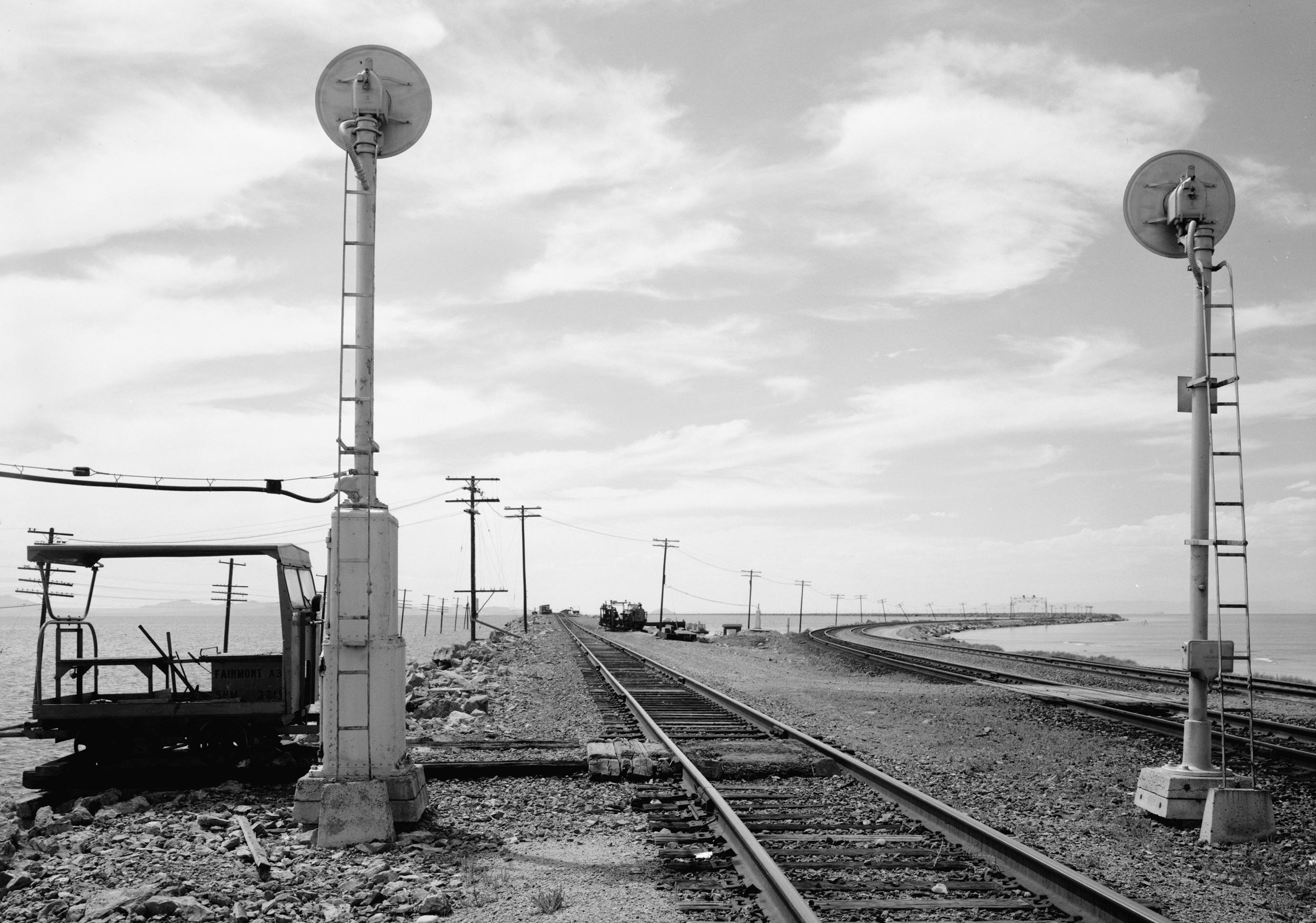 A ground-level view of the original (left) and current (right) Lucin Cutoffs taken in August, 1971 by Jack Boucher. The searchlight signals protected the original alignment, which has been entirely removed today.
A ground-level view of the original (left) and current (right) Lucin Cutoffs taken in August, 1971 by Jack Boucher. The searchlight signals protected the original alignment, which has been entirely removed today.From there the line clipped the southern edge of Promontory Point and then continued on to another short fill before exiting to the eastern shoreline.
The route was wide enough to accommodate two tracks and shaved off 43 miles of the original alignment, reducing the total distance between Ogden and Lucin to just 103 miles.
Interestingly, Salt Lake City officials had initially hoped to lure the railroad directly through their town. However, this would have required an additional 70 miles of new railroad and the SP saw this as unnecessary.
Completion
In the end, the original Lucin cutoff cost $4.5 million and officially opened to all through traffic on January 1, 1905. Surprisingly, the SP still used the original routing, naming it the Promontory Branch to serve remaining shippers and passengers.
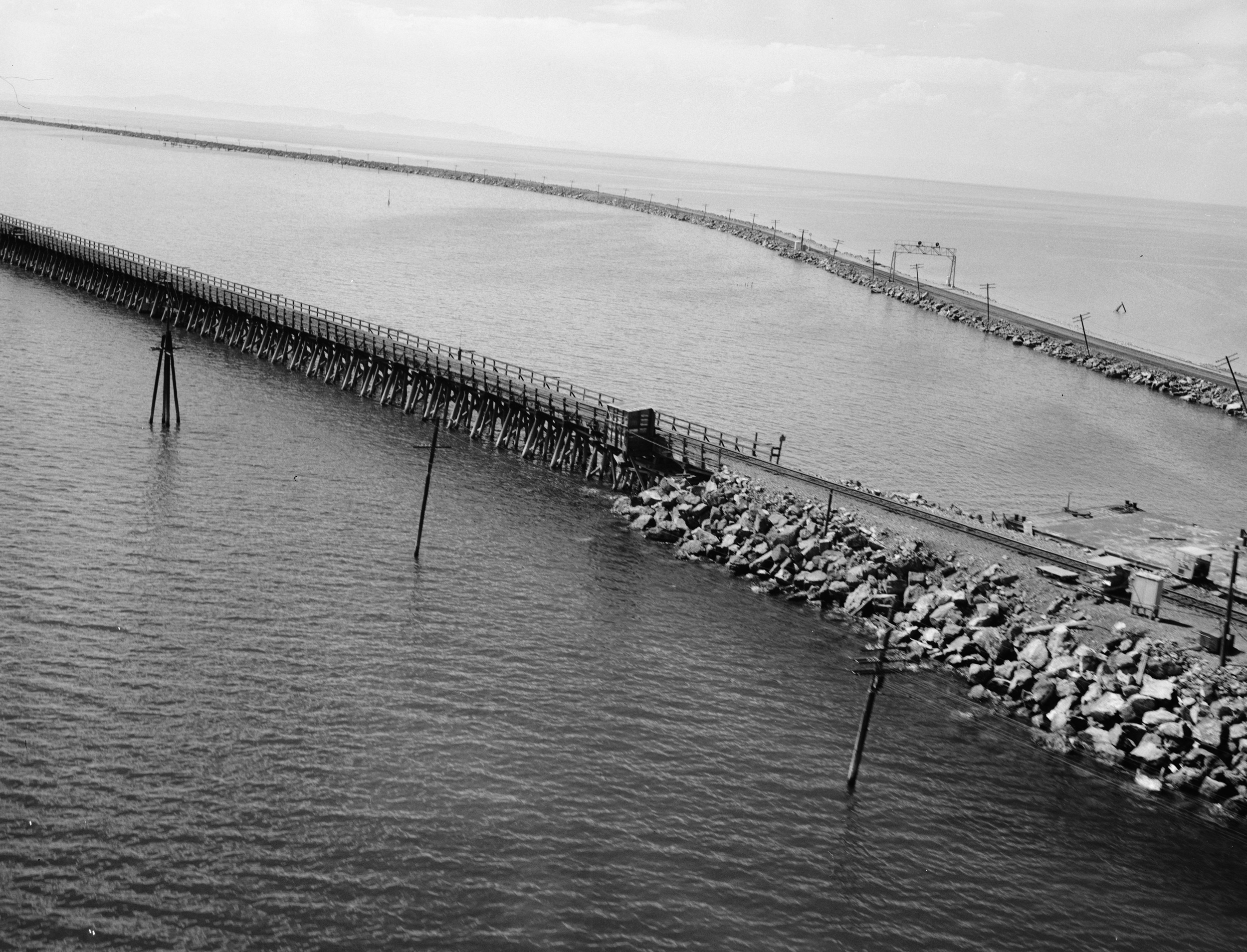 A northwestward view of the original and current Lucin Cutoffs. Note that much of the original alignment was constructed using wood pilings, which was rapidly aging in the salty water. The new right-of-way was built entirely with fill. Jack Boucher photo.
A northwestward view of the original and current Lucin Cutoffs. Note that much of the original alignment was constructed using wood pilings, which was rapidly aging in the salty water. The new right-of-way was built entirely with fill. Jack Boucher photo.After nearly 10 years of failed attempts the railroad finally abandoned much of this line (55 miles) after June, 1942. By this time the Lucin's final chapters were also being written.
The wooden trestle was showing considerable age by that time after five decades of constant use. It was also becoming a bottleneck as trains were forced to crawl over the structure at only 15 mph.
Age was not the only issue. The railroad also worried about fire consuming the woodn supports. As such, in 1950 the company began primarily studies to construct a new alignment that would be a full length, earthen causeway built entirely of stone fill.
Map (1968)
Great Salt Lake Causeway
The Great Salt Lake Causeway, a monumental achievement in the realm of railroad engineering. Signifying a strategic drive towards enhanced inter-state transportation, the construction of this enormous causeway marked the dawn of a new era in the history of US railways.
The Southern Pacific, known for its commitment to superior transportation mechanisms, the company ensured that the construction of the Great Salt Lake Causeway was carried out with no compromise on quality, precision, and safety.
Work on the causeway began in 1955, contracted to the Morrison-Knudsen Company (today, well known for its locomotives).
To reduce costs the Southern Pacific elected to reuse the original eastern and western approaches with the primary work aimed at replacing the roughly 12 miles of trestle.
The new alignment was located about 1,500 feet to the north of the bridge and required nearly 30 feet of sediment from the lake's floor dredged to reach bedrock and sustain a solid foundation.
The construction required an enormous quantity of rocks and fill. For stability and endurance, a staggering 40,000 tons of rock was poured into the causeway every day during construction. This ensured the structure was designed to withstand the relentless pressures of time, nature, and constant use.
After four years of work the Great Salt Lake Causeway's right-of-way was completed on July 9, 1959 and turned over to the SP for final track laying and signaling.
This work required another month to finish and but by late August trains were once again rolling across the lake. In all, the project cost a total of $50 million. The original trestle remained were it stood and its remnants can still be seen today. The current line from Lucin to Ogden totals 102.4 miles.
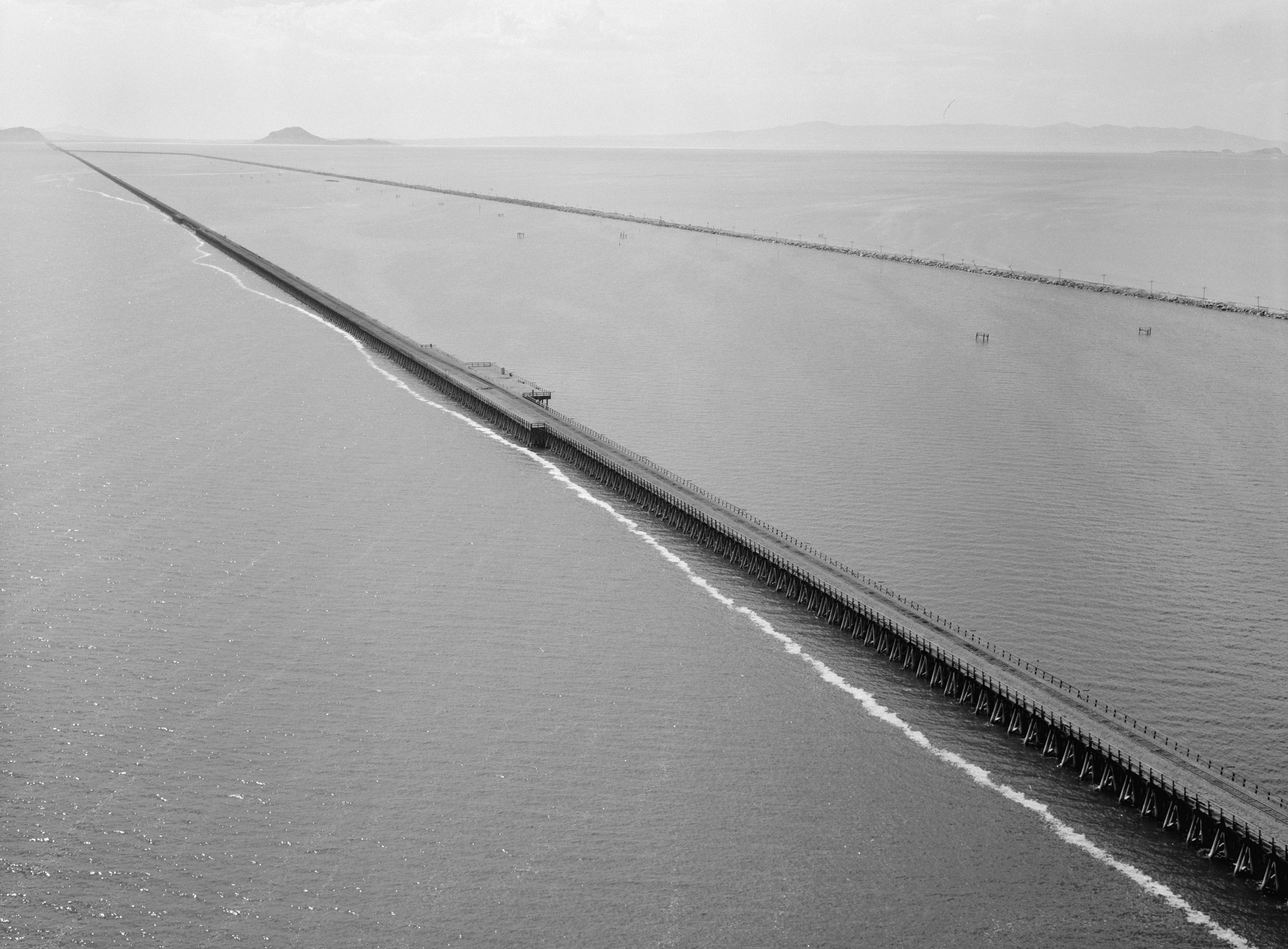 Another aerial view of the two alignments looking west. Far in the distance you can see where the new grade ties into the original. Jack Boucher photo.
Another aerial view of the two alignments looking west. Far in the distance you can see where the new grade ties into the original. Jack Boucher photo.Today
In the mid-1980s a 300 foot trestle interestingly had to be reinstalled to allow for proper water flow as the northern section was several feet lower than its southern counterpart.
The 1980s also saw the causeway nearly swamped due to the lake's unpredictable water levels. It had to be closed several times because of washouts and cost the railroad $85 million in maintenance repairs during the decade.
Since that time, however, the lake has never experienced such heavy flooding. Today, the Great Salt Lake Causeway remains an important artery in the Union Pacific's system (since its 1996 takeover of SP) despite the fact that it has a parallel route to Salt Lake City via the old Western Pacific alignment.
The causeway is as critical to the railway network as it is to environmental conservation, with various measures being undertaken to mitigate its impact on critical habitats and ecosystems.
Even after decades of use, the Great Salt Lake Causeway continues to hold immense strategic importance. Ongoing efforts to manage and preserve the causeway serve as a testament to its continuing relevance.
Looking back, the Great Salt Lake Causeway stands as a testament to the fortitude and ambition of the Southern Pacific and later the Union Pacific railroads. Its construction, operation, and adaptation over the years are a reflection of the evolving narrative of American railroad history.
Overall, the Great Salt Lake Causeway is a compelling blend of engineering prowess, infrastructural fortitude, and ecological interplay. It rises above its role as a mere transport facilitator, embedding itself deep in the heart of American industrial history, geographical transformation, and environmental discourse.
Recent Articles
-
Arizona Railroad Museums: A Complete Guide
Apr 16, 25 01:17 PM
Learn about Arizona's rich history with railroads at one of several museums scattered throughout the state. More information about these organizations may be found here. -
Arkansas Railroad Museums: A Complete Guide
Apr 16, 25 12:59 PM
The state of Arkansas is home to a handful of small railroad museums. Learn more about these organizations here. -
Alabama Railroad Museums: A Complete Guide
Apr 16, 25 12:30 PM
Alabama, with its storied past and vibrant connection to the railroad industry, is home to several captivating railroad museums.
